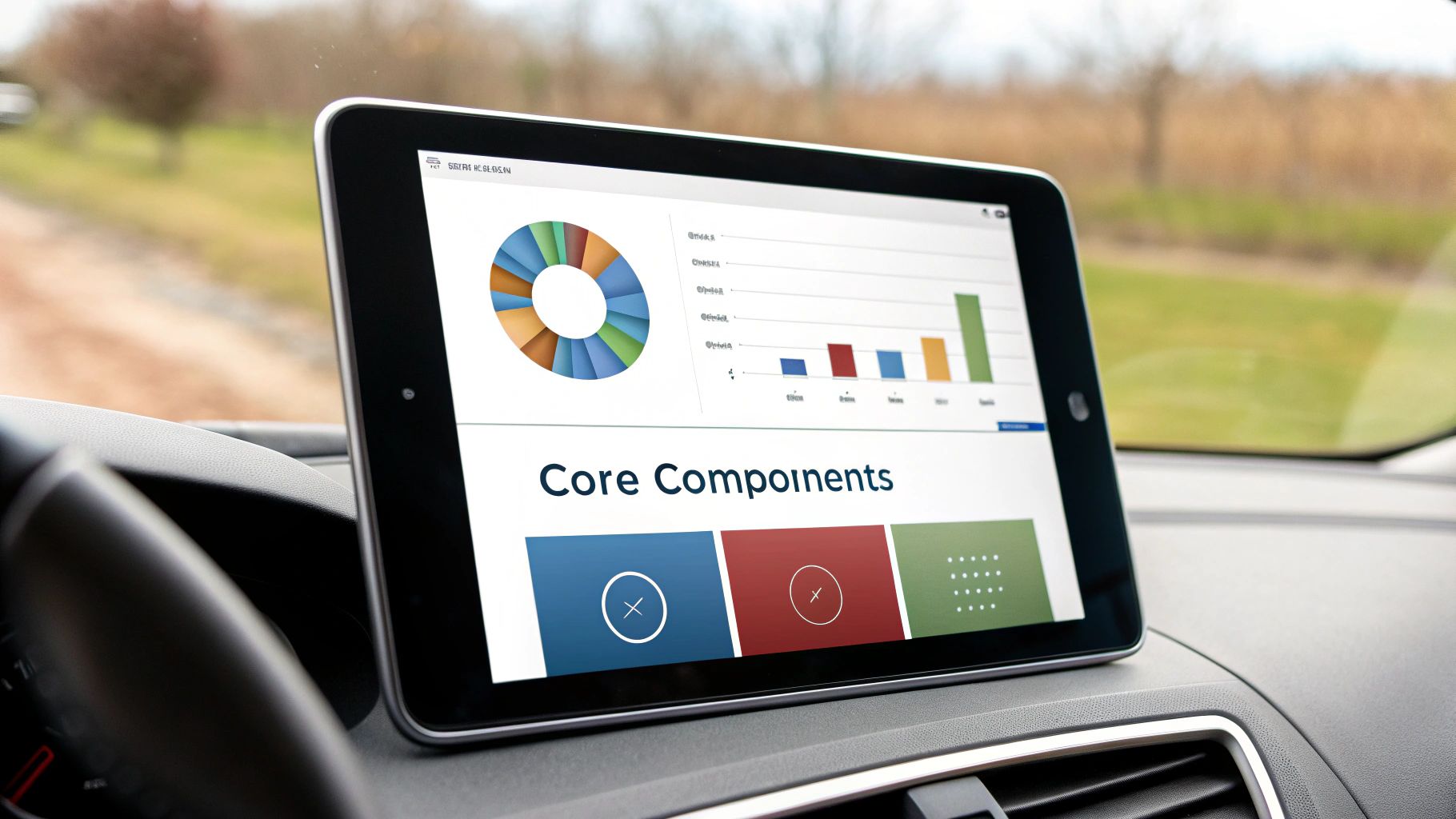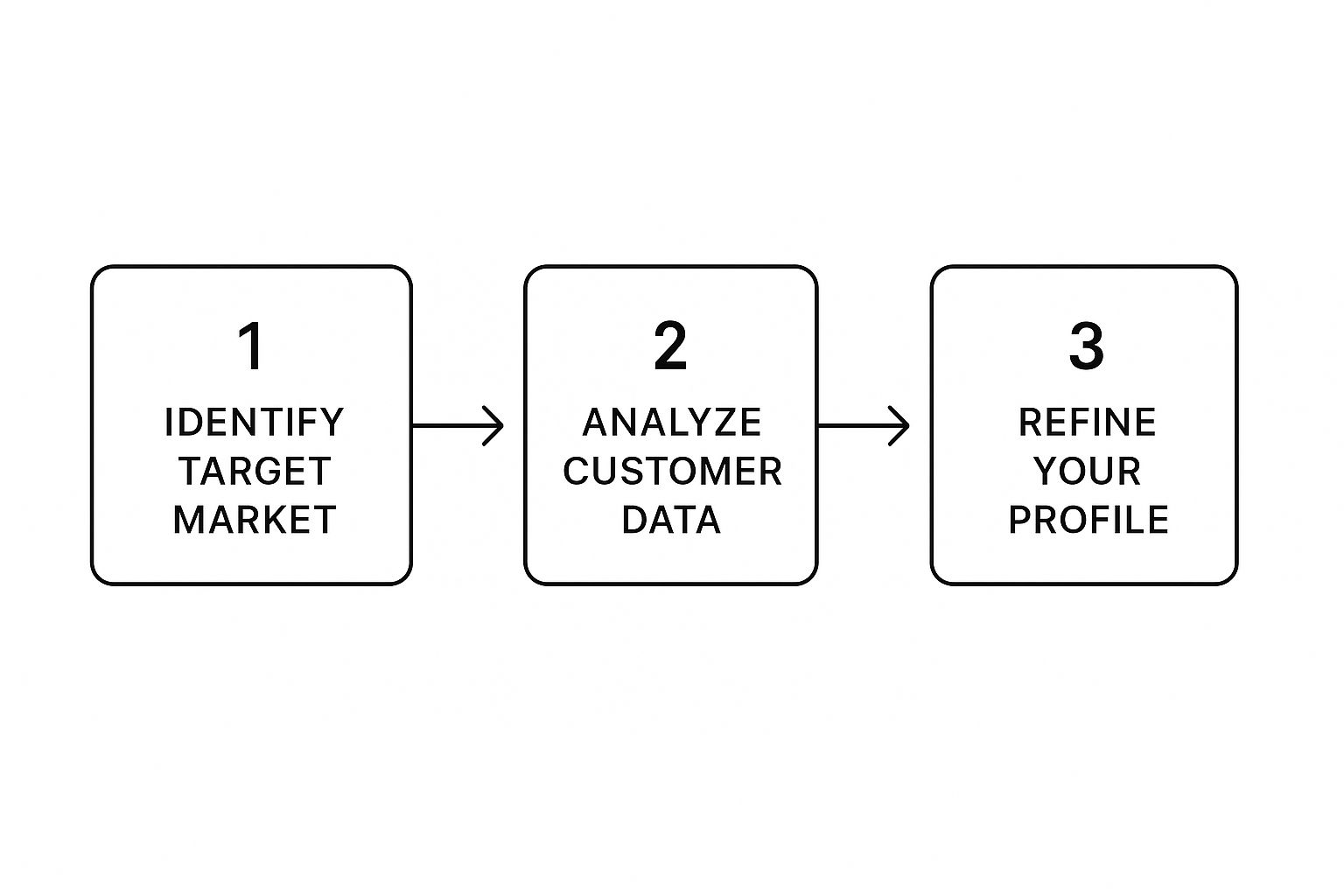B2B Ideal Customer Profile: Your Complete Guide to Success
- Prince Yadav
- Jun 18
- 13 min read
Why Most B2B Ideal Customer Profiles Miss The Mark
Many B2B leaders create what they believe is a solid b2b ideal customer profile, only to see it gather digital dust and fail to produce meaningful results. The hard truth is that most ICPs are built on a shaky foundation of assumptions and basic firmographics. They look impressive in a slide deck but are ineffective in the real world, becoming static documents instead of strategic tools.
Imagine a detective trying to solve a case using only a suspect's height and eye color. While that information is a start, it's far too generic to pinpoint the right person. An ICP that only lists company size, industry, and location makes the same mistake—it misses the most important clues: the behaviors and triggers that signal a real need for your solution. This is a primary reason why so many well-intentioned profiles miss the mark entirely.
From Static Descriptions to Dynamic Intelligence
The most common pitfall is treating the ICP as a one-time project. A successful profile isn't a fixed description; it's a living, breathing set of characteristics that changes with your market. The companies that win are those that move from educated guesses to data-driven customer intelligence. They understand that an effective b2b ideal customer profile is less about who a company is and more about what that company does and needs right now.
This means looking beyond the surface to spot deeper patterns. You need to ask more insightful questions:
What recent events, like a new funding round or an executive hire, create an opening for you?
What technology are they currently using (or dropping) that points to a problem you can solve?
How do they talk about their challenges in public forums, press releases, or annual reports?
Answering these questions transforms your ICP from a simple checklist into a powerful predictive model. This alignment is critical, ensuring both sales and marketing focus their energy on converting the most valuable potential customers. For a deeper look into this alignment, you can find more details about creating a B2B ideal customer profile from expert analysis on Gartner.com.
The Peril of the "Perfect" On-Paper Customer
Another major mistake is confusing your favorite customers with your best customers. A company you love working with might not be your most profitable, have the shortest sales cycle, or offer the best potential for growth. Strong ICPs are rooted in an objective analysis of your most successful accounts—those with high lifetime value, low churn, and a history of strong advocacy.
By focusing on these data-backed attributes, you build a profile that directly supports revenue growth and operational efficiency. The outcome is a more focused strategy, leading to higher-quality conversations and, ultimately, better leads. You can explore more on this topic in our guide on B2B lead generation strategies that actually work.
The Hidden Cost Of Operating Without A Clear ICP

Thinking you don't have time to develop a b2b ideal customer profile is a common but expensive mistake. In reality, operating without one is like trying to captain a ship through a storm with no compass. You'll burn a tremendous amount of energy and resources, but you’ll probably end up far from your destination. This "spray-and-pray" method has ripple effects that many businesses don't see until their budgets are gone and their teams are exhausted.
The costs aren't always easy to spot on a balance sheet. They hide in plain sight as wasted ad spend targeting uninterested groups, marketing content that falls flat, and a sales team burning out from chasing low-quality leads. When your team doesn’t know who they are selling to, every action is less effective. This leads to longer, more expensive sales cycles with lower win rates.
The Modern Buyer Makes Your ICP Non-Negotiable
This problem is made worse by the behavior of today’s well-informed B2B buyers. The modern decision-making process is mostly self-guided. Research shows that between 57% and 70% of the buyer's journey is finished before they even speak to a sales representative. These buyers are looking for partners who understand their specific problems from the very first touchpoint. Without a precise ICP, your messaging stays generic and fails to build the early trust needed to even get on their radar. You can find out more about how buyer behavior has changed by reading these key B2B marketing statistics.
Turning Costs Into Opportunities
A well-defined ICP completely changes the game. It works as a filter, making sure your efforts are focused only on prospects with the highest chance of success. The results are immediate and build over time:
Improved Conversion Rates: Marketing campaigns become laser-focused, bringing in prospects who are already a great match.
Shorter Sales Cycles: Sales conversations begin from a place of understanding, tackling real pain points instead of just listing features.
Higher Customer Lifetime Value (CLV): You bring in customers who get the most value from your solution, which means better loyalty and less churn.
Enhanced Lead Qualification: Your team can quickly spot and prioritize the best opportunities, a process you can improve with our sales lead qualification checklist.
Ultimately, investing time in developing your ICP isn't an expense. It's one of the best investments you can make to build a predictable and scalable revenue machine.
The Three Pillars Of High-Converting Customer Profiles

Think of it like a three-legged stool: if you remove any one leg, the entire structure wobbles and becomes unstable. These pillars are what help you separate the companies that could buy from you from the ones that almost certainly will.
Firmographics: The Foundation of Fit
The first pillar is firmographics, which are the basic, quantifiable facts about a company. This is your first filter, helping you narrow down the entire market to a group of companies that are a fundamental match for your business. These details are the non-negotiable starting point for qualification.
Key firmographic data points include:
Industry: Do they work in a vertical you have experience and success in?
Company Size: Is their employee count or annual revenue within your target range?
Geography: Are they located in a region you can legally and efficiently serve?
Business Structure: Is their model (e.g., B2B SaaS, enterprise, franchise) a good match for your solution?
Technographics: The Tools of the Trade
Next up is technographics, which tells you what technologies a company is currently using. This data provides powerful context, showing not just who they are, but how they operate. It’s like looking inside their toolbox before you try to sell them a new hammer.
A company that just dropped a competitor's software is sending a strong buying signal. Likewise, a business using tools that integrate well with your own suggests a smoother adoption process and a higher chance of success. This information allows you to adjust your messaging to fit their current operational reality.
Behavioral Data: The Signals of Intent
The final, and perhaps most critical, pillar is behavioral data. This category tracks the actions and signals that show a company is actively searching for a solution right now. These are the digital breadcrumbs that lead you straight to a prospect who is ready to talk.
Actions like downloading a whitepaper on a specific problem, visiting your pricing page multiple times, or making a key executive hire all point to an active buying journey. This data is what transforms a static description into a dynamic targeting tool, allowing you to engage at the perfect moment. To go deeper on this, you can master B2B lead scoring with our guide and learn how to weigh these actions accurately.
To help you understand how these pillars fit together, we've broken down the essential data points you'll need to collect. The table below compares them by category, impact, and how difficult they are to find.
Data Category | Key Metrics | Impact Level | Collection Difficulty | Best Sources |
|---|---|---|---|---|
Firmographics | Industry, Company Size, Revenue, Location, Business Model | Medium | Low | Public records, LinkedIn, Company Websites, ZoomInfo |
Technographics | CRM, Marketing Automation, Cloud Services, Analytics Tools | High | Medium | Technology databases (BuiltWith), Job Postings, G2, Case Studies |
Behavioral Data | Website Visits, Content Downloads, Demo Requests, Social Media Engagement | Very High | High | Website Analytics, Marketing Automation Platforms (HubSpot), Sales Intelligence Tools |
As the table shows, the most impactful data—behavioral signals—is often the hardest to collect. However, combining all three pillars gives you the most complete picture of your ideal customer, allowing you to focus your efforts where they will have the greatest effect.
Building Your Data-Driven ICP From The Ground Up
Creating a b2b ideal customer profile that actually moves the needle isn't about guesswork; it's a structured process of turning raw data into actionable intelligence. This framework helps you look past assumptions and use hard evidence to define who your best customers really are—not just who you think they are. The journey begins by looking inward at the customers you’ve already won over.
Step 1: Analyze Your Most Valuable Customers
First, you need to identify your "super users"—the customers who get the most from your solution and, in turn, provide the most value back to your business. This isn't about picking your favorite clients or the ones with the biggest names. It's about digging into your data with a critical eye, searching for metrics that signal a genuinely successful partnership.
Look for common threads among customers who exhibit:
High Customer Lifetime Value (CLV): They consistently spend more with you over the long haul.
Low Churn Rates: They stick around because your solution delivers real, tangible results for them.
High Product Adoption: They don't just use your product; they use it extensively and effectively.
Strong Advocacy: They are your biggest fans, providing glowing testimonials, case studies, or referrals without prompting.
The core of building an ICP is pinpointing these high-value customers and analyzing their shared traits like industry, company size, and specific pain points. Using your CRM and Account-Based Marketing (ABM) platforms, you can filter this list by focusing on profitability, how long they've been a customer, and satisfaction scores. For a deeper dive into this approach, you can explore the complete process for defining a B2B ICP on Dealfront's blog.
The visual below shows the basic flow for putting your profile together.

As the infographic highlights, creating an effective ICP isn't a one-and-done task. It's a continuous cycle of identification, analysis, and refinement.
Step 2: Conduct Insightful Customer Interviews
Once you've identified a list of 5-10 ideal customers, it's time to talk to them directly. The goal isn't to fish for compliments; it's to uncover the "why" behind their success with your product. Standard surveys often give you polite but ultimately unhelpful answers. Instead, schedule brief interviews and ask open-ended questions designed to reveal their story.
Focus your questions on discovering:
The Trigger Event: What specific event or problem pushed their business to start searching for a solution like yours?
The Buying Process: Who was involved in making the final decision, and what were their biggest concerns or hesitations?
The "Aha!" Moment: At what point did they realize your solution was the right choice? What feature or benefit sealed the deal?
Measured Success: How do they quantify the value your product brings? Are they saving time, increasing revenue, or reducing costs?
Step 3: Synthesize and Validate Your Findings
Finally, it's time to bring everything together. Combine the quantitative data from your analysis with the qualitative insights from your interviews. Look for recurring themes across firmographics, technographics, and buying behaviors. This synthesis creates the first draft of your data-driven b2b ideal customer profile.
But don't stop there. The final step is validation. Test this new profile against broader market data and run small, targeted campaigns before a company-wide rollout. This ensures your ICP is specific enough to be effective yet broad enough to support scalable growth.
Managing Multiple ICPs Without Losing Focus
As your business scales, you'll probably discover that your original b2b ideal customer profile feels a bit too tight. It's like trying to fit everyone into the same pair of shoes. You might be serving both growing tech companies and large financial institutions. While both are "ideal," their needs, buying cycles, and challenges are entirely different. Trying to market to them with the same message is like giving the same directions to people going to different destinations—it just doesn't work.
But this doesn't mean you should create a dozen different ICPs. A common misstep is over-segmentation, which dilutes your marketing focus, confuses your messaging, and stretches your resources too thin. The goal is to strike a strategic balance, creating new profiles only when there's a compelling business reason.
When to Create a New ICP
Before you decide to split your focus and create another ICP, you need a very clear "why." A new profile is typically justified only in specific situations. For example, launching a new product designed for a completely different type of user is a solid reason. Likewise, expanding into a new industry like healthcare, with its own set of rules and operational needs, requires its own dedicated ICP.
Think about these triggers as signs that it's time to build a new profile:
Significant Vertical Differences: The industry you're targeting has unique regulations, terminology, or workflows that demand specialized messaging. Selling to a government agency, for instance, is a world apart from selling to a SaaS startup. This is where tailored outreach becomes essential, a topic we explore in our complete growth playbook for SaaS.
Varying Company Sizes: The pain points and decision-makers at a 50-person company are vastly different from those at a 5,000-person enterprise. If your solution caters to both, separate ICPs help you tailor your pitch to each segment's distinct operational scale and challenges.
Distinct Geographic Needs: Sometimes, regional factors like local laws, economic climates, or business customs can dramatically change the sales process. If these differences are significant, a geography-specific ICP might be necessary to connect with that market effectively.
To help you decide when and how to segment, here is a framework that outlines different strategies based on your market and business goals.
ICP Segmentation Strategy Matrix
Segmentation Type | When to Use | Complexity Level | Resource Requirements | Expected ROI |
|---|---|---|---|---|
Single, Unified ICP | Early-stage business with one core product/market. | Low | Low | High (Focus) |
Sub-Segments | Minor variations in needs within a core ICP (e.g., different job titles). | Medium | Medium | Medium-High |
Vertical-Specific ICPs | Entering industries with unique regulations or workflows (e.g., Healthcare vs. Finance). | High | High | High (Market Penetration) |
Company Size-Based ICPs | Serving both SMB and Enterprise markets with different sales cycles. | Medium-High | High | High (Scalability) |
Geographic ICPs | Expanding into new regions with distinct cultural or legal requirements. | High | Very High | Variable (Market Dependent) |
Ultimately, the aim is to create just enough ICPs to keep your messaging sharp and relevant without overwhelming your teams. Each new profile must represent a sizable market segment that requires its own go-to-market strategy. If the sales approach, primary pain points, and messaging are 90% identical, you likely just need a sub-segment, not a brand-new ICP.
Testing And Evolving Your ICP For Sustained Growth
A B2B ideal customer profile isn't something you create once, frame, and then forget about. It's a dynamic tool that needs regular attention to stay sharp. Building your initial profile is just the beginning. The real payoff comes from treating it like a living hypothesis—one that you must constantly test, validate, and adjust based on what the market is telling you. If you don't, even the most carefully built ICP will become outdated and lose its strategic edge.
Think of your ICP as a navigation chart for your business. It's based on the best information you have right now, but things can change unexpectedly—market currents shift, new competitors appear, and customer behaviors evolve. A smart captain constantly updates their charts with fresh data to stay on the right course. Your business must do the same.
How to Test and Refine Your ICP
The goal is to run small, controlled experiments that check your assumptions without disrupting what’s already working. This process builds a vital feedback loop between your marketing, sales, and product teams, making sure everyone is guided by the most current customer intelligence.
Here are a few practical ways to test and evolve your profile:
A/B Test Outreach Criteria: Launch parallel outreach campaigns aimed at slightly different ICP segments. For instance, you could test messaging for companies with 50-100 employees against those with 101-250 employees. See which group gives you more high-quality meetings to fine-tune your company size criteria.
Analyze Conversion Patterns: Make it a habit to review your sales pipeline data. Are deals from a certain industry closing faster than others? Do customers using a specific technology end up having a higher lifetime value? These patterns are clear clues that your ICP might be too broad or too narrow.
Monitor Customer Feedback: Pay close attention to customer reviews and support tickets. If customers who fall outside your current ICP are getting huge value from your product, it could be a sign of an emerging market opportunity you haven't considered.
To keep your ICP relevant, it’s critical to have a single, unified view of all customer interactions. The screenshot below from Salesforce's Customer 360 platform shows how centralizing this data gives you a complete picture.
This visual demonstrates how pulling together data from sales, service, and marketing creates one source of truth. This makes it much easier to spot trends and make informed adjustments to your ICP.
Warning Signs Your ICP Needs an Update
Your ICP isn't built to last forever. Be on the lookout for these signals that it's time for a refresh:
Declining Lead Quality: If your sales team repeatedly says that marketing-qualified leads aren't a good fit, your profile is probably out of sync with what the market actually looks like.
Stagnant Win Rates: A slowdown in your sales conversion rates could mean your messaging no longer connects with your target audience.
Market Disruption: Big industry shifts, new technologies, or major economic changes can make parts of your ICP obsolete almost overnight.
By building a system for regular testing and evolution, you ensure your B2B ideal customer profile remains a powerful asset that drives sustainable growth.
Turning Your ICP Into Organizational Action

A B2B ideal customer profile gathering dust in a folder is a wasted effort. Its true power is unlocked only when you weave it into the daily fabric of your entire company. To make this a reality, your ICP must evolve from a theoretical document into a practical tool that guides how your teams operate, from generating leads to ensuring customer happiness.
Think of your ICP as the architectural blueprints for a new house. The plans are critical, but they can't build the house on their own. You need the construction crew—your sales, marketing, and product teams—to follow those blueprints precisely every single day. If they don't, you’ll end up with a wobbly structure that looks nothing like the original vision.
Embedding Your ICP Across Departments
To ensure your ICP doesn’t become just another forgotten document, you have to translate its insights into clear, actionable guidelines for each department. This transforms your profile from an abstract idea into a concrete operational playbook everyone can follow.
For Sales Teams: The ICP should be the primary filter for all prospecting. It dictates how to qualify leads and prioritize who gets a call first. Sales development representatives (SDRs) can use it to build highly focused account lists, making sure their energy is spent on prospects with the highest likelihood of becoming customers. This targeted approach is a key part of many effective outbound lead generation strategies.
For Marketing Teams: Your ICP acts as a compass for all campaigns and content. Every blog post, webinar, and ad should be crafted to speak directly to the challenges and ambitions of your ideal customer. This ensures your message connects on a deeper level, attracting high-quality inbound leads.
For Customer Success Teams: Understanding the ICP gives the success team a head start on a new customer's goals. This knowledge paves the way for a smoother onboarding process and proactive support, which drives higher retention rates and helps spot opportunities for upselling.
Creating Accountability and Measuring Success
Putting the ICP into practice demands accountability. Success isn't just about creating the profile; it's about how well teams stick to it. Tie team and individual performance goals to ICP-focused activities to keep everyone on the same page.
For instance, a key metric for marketing could be the percentage of new leads that match the ICP. For sales, it might be the win rate for deals that align with the profile. When the B2B ideal customer profile is directly connected to results, it becomes a vital tool for growth, not just another corporate initiative.
Ready to fill your pipeline with meetings that fit your ideal customer profile? Fypion Marketing guarantees qualified appointments, and you only pay for results. Book a free consultation today and start closing more of the right deals.
Comments